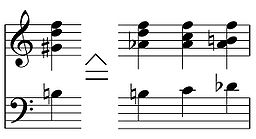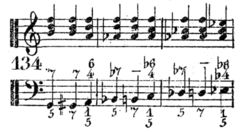Voglerscher Tonkreis
The voglersche tone circle (after Georg Joseph Vogler ), also known as "Devil's Mill", is a harmonic sequence , in which a chromatically ascending or descending bass with dominant seventh -, reduced Sept and minor - Quartsextakkorden connects. All voices in the sentence model are moving in opposite or sideways movement to one another : each upper part goes in the opposite direction of the bass, while the others remain where they are (Fig. 1).
functionality

The basic building block of the sequence is a series of three chords, which usually delay an imminent cadence (example 2). One can describe the chord progression in the sense of Heinrich Schenker as a prolongation of a seventh chord (VII 7 / V) by swapping voices (whereby the sixth fourth chord is a random continuation), or harmoniously explain the sixth chord as the dominant cadenza chord , to which the two four chords (diminished seventh and excessive fifth sixth chord) are directly related as double dominants . (The enharmonic spelling of the individual sounds varies greatly.)

The extension of this chord progression to the sequence is achieved by adding a fourth chord, which is the inverse of the first and can thus lead back to the sixth fourth chord or, with ascending bass, further via the leading note into the tonic . Instead, this chord is reinterpreted enharmonically and made the beginning of a new building block whose key is a minor third from the original key (example 3). This sequence of small incisions creates a harmonious tonal state of suspension, which can only be ended by leaving the model. At the same time, the melody is suspended by the standstill of the upper voices, since a note can be recorded over eight different chords. This lying tone is mostly found in the soprano (Ex. 1).
variants
The chord progression can be used "forwards" and "backwards". Another, historically somewhat more recent variant (Ex. 4) emphasizes the moment of countermovement , in that instead of the diminished seventh chord, a second or diminished third chord appears (depending on the way of writing or viewing). Here the upper parts move consistently in semitone steps, but only stay over seven chords. This variant can be found almost exclusively with descending bass and ascending upper part. In English-language music theory, this sequence is mostly derived from the so-called omnibus progression .
history
After approaches by J. S. Bach (e.g. in the first bars of the recitative "And lo and behold, the curtain in the temple tore" of his St. Matthew Passion ), the sentence model is clearly developed for the first time in Haydn's Symphonies No. 45 ( F sharp minor , “Abschied”, 1772, 2nd movement) and 65 ( A major , approx. 1769–1772, 1st movement).
Georg Joseph Vogler , who was probably not familiar with these compositions, published a "round tone circle" in his Tonwissenschaft und Tonsezkunst (1776), which contains the complete model in all three possible transpositions (Fig. 5). Vogler could have developed the process independently or got to know it during his two-year studies in Italy.
From the end of the 1770s, Carl Philipp Emanuel Bach also used the tone circle, who either knew Vogler's treatise or must be considered the third inventor: A posthumously made copy of his sketches shows various experiments with chromatic lateral movement, including the tone circle.
From around 1785 there is almost no German composer who has not used the model at least once: Mozart , Beethoven , Hummel , J. H. Knecht , Reichardt and many more. In 1805, Emanuel Aloys Förster spoke of the “so-called devil's mill” in his instructions for the general bass , thus quoting an apparently common nickname ( comparable to the “ Schusterfleck ”).
Nevertheless, even in the 19th century, excerpts, variants and extensions of the harmony model, but also the model itself, continued to be used for compositional purposes. Due to the basically non-tonal procedure of a geometric (equidistant) octave division, the “Teufelsmühle” may have contributed to the development of modern music: The upper voices of the tone circle together form an octatonic scale (also known as Messiaen's 2nd mode), which is in the Russian and French modernism is of great importance.
literature
- Miscellanea Musica by C. P. E. Bach. (Wq 21). MS, B-Bc, shelf no. 5895 (RISM A / II 703.000.233), p. 9. Description in: Ulrich Leisinger , Peter Wollny : The Bach sources of the libraries in Brussels. Catalog. With a presentation of the tradition and significance of the Westphal, Fétis and Wagener collections (= Leipzig contributions to Bach research. Vol. 2). Olms, Hildesheim et al. 1997, ISBN 3-487-10303-6 , pp. 352-355.
- Marie-Agnes Dittrich : "Teufelsmühle" and "Omnibus". In: Journal of the Society for Music Theory. Vol. 4, No. 1/2, 2007, ISSN 1862-6742 , pp. 107-121 .
- Joseph Drechsler : Harmony and figured bass teaching; together with an appendix from the contrapuncte. For use in public lectures at the k. k. Normal secondary school to St. Anna in Vienna. 2nd, improved edition. Tobias Haslinger, Vienna 1820, ( digitized ).
- Emanuel Aloys Förster : Instructions for the general bass. Breitkopf & Härtel, Leipzig 1805, ( digitized version ).
- Robert Gauldin: The theory and practice of chromatic wedge progressions in romantic music. In: Music Theory Spectrum. Vol. 26, No. 1, 2004, pp. 1–22, doi : 10.1525 / mts.2004.26.1.1 .
- Peter Giesl: From voice leading to small circles. An interpretation of the devil's mill by the Clausel theory. In: The music research . Vol. 54, No. 4, 2001, pp. 378-399, JSTOR 41124857 .
- Ludwig Holtmeier : Devil's Mill. In: Heinz von Loesch , Claus Raab (ed.): Das Beethoven-Lexikon (= The Beethoven-Handbuch. Vol. 6). Laaber Verlag, Laaber 2008, ISBN 978-3-89007-476-4 , pp. 763-764.
- Heinrich Poos : Carl Philipp Emanuel Bach's Rondo in A minor from the “Second Collection [...] for Connoisseurs and Lovers”. Protocol of an Approach. In: Heinrich Poos (Ed.): Carl Philipp Emanuel Bach. Contributions to life and work. Schott, Mainz et al. 1993, ISBN 3-7957-1864-3 , pp. 119-170.
- Peter Schubert: "A New Epoch of Polyphonic Style": Schoenberg on Chords and Lines. In: Music Analysis. Vol. 12, No. 3, October 1993, pp. 289-319, doi : 10.2307 / 854147 .
- Elmar Seidel: A chromatic harmonization model in Schubert's Winterreise. In: Carl Dahlhaus , Reiner Kluge, Ernst H. Meyer , Walter Wiora (eds.): Report on the International Musicological Congress, Leipzig 1966. Deutscher Verlag für Musik VEB, Kassel et al. 1972, pp. 437–451.
- Elmar Seidel: About the connection between the so-called Teufelsmühle and the 2nd mode with limited transposability in Liszt's harmony. In: Serge Gut (Ed.): Papers of the 2nd European Liszt Symposium. Eisenstadt 1978 (= Liszt Studies. 2). Katzbichler, Munich et al. 1981, ISBN 3-87397-190-9 , 172-206.
- Paula J. Telesco: Enharmonicism and the Omnibus Progression in Classical-Era Music. In: Music Theory Spectrum. Vol. 20, No. 2, 1998, pp. 242-279, doi : 10.2307 / 746049 .
- Christian Thorau: "Bold, never heard of and yet newsworthy". On the so-called devil's mill in Carl Philipp Emanuel Bach's Fantasies. In: Heinrich Poos (Ed.): Carl Philipp Emanuel Bach. Contributions to life and work. Schott, Mainz et al. 1993, ISBN 3-7957-1864-3 , pp. 171-196.
- Georg Joseph Vogler: Tonwissenschaft and Tonsezkunst. sn, Mannheim 1776, ( digitized version ).
- Georg Joseph Vogler: Kuhrpfälzische Tonschule. At the expense of the author, Mannheim 1778, ( digitized version ).
- Georg Joseph Vogler: Handbook for harmony theory and for the figured bass, according to the principles of the Mannheim Tonschule, for the purpose of public lectures in the orchestrion hall at the Imperial and Royal Karl Ferdinand University in Prague. Karl Barth, Prague 1802, ( digitized version ).
- Robert W. Wason: Viennese Harmonic Theory from Albrechtsberger to Schenker and Schoenberg (= Studies in Musicology. Vol. 80). UMI Research Press, Ann Arbor MI 1985, ISBN 0-8357-1586-8 ( Also : New Haven CT, University, Dissertation, 1981: Fundamental Bass Theory in Nineteenth Century Vienna. ).
- Victor Fell Yellin: The Omnibus Idea (= Detroit Monographs in Musicology, Studies in Music. 22). Harmonie Park Press, Warren MI 1998, ISBN 0-89990-081-X .


